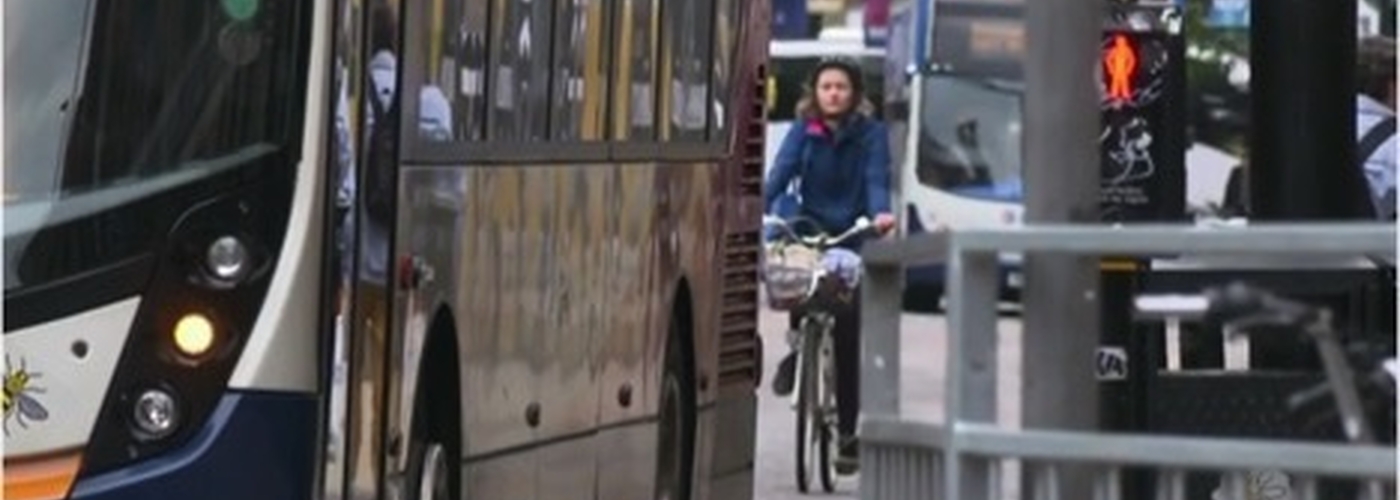Andrea Sandor investigates the scandal of removing cycle lanes on Great Ancoats Street
Last week, Manchester City Council declared a Climate Emergency. Now it faces its first real test to show whether the declaration is backed with deeds - or if it’s all just hot air.
In May the Council unveiled £9.1m plans to revamp Great Ancoats Street, styling it into a ‘European boulevard’ with added trees and improved pedestrian crossings. However, the scheme has come under fire for removing cycle lanes and doing nothing to alleviate the illegal and lethal air pollution levels those living and working in the area are exposed to.
While there had been a brief consultation in 2018, it was hardly publicised, poorly attended, and plans stated 'no overall change' despite the removal of cycle lanes
Following vitriolic backlash against the scheme, including a protest and rally covered by BBC and ITV news crews, the plans went before the Environmental Scrutiny Committee yesterday. In an incredible turn of events, the Committee recommended the plans be sent back to public consultation, despite preparatory works already having started on the controversial scheme.
The recommendation will go before the Executive next Wednesday, when all eyes will be watching whether those at the top will back the Climate Emergency with deeds – or if the declaration is purely rhetoric.
While the Council may claim it’s too late to put a brake on the scheme, its critics argue that a Climate Emergency mandates all schemes be reevaluated in light of the declaration. Otherwise, what’s the point of an emergency?
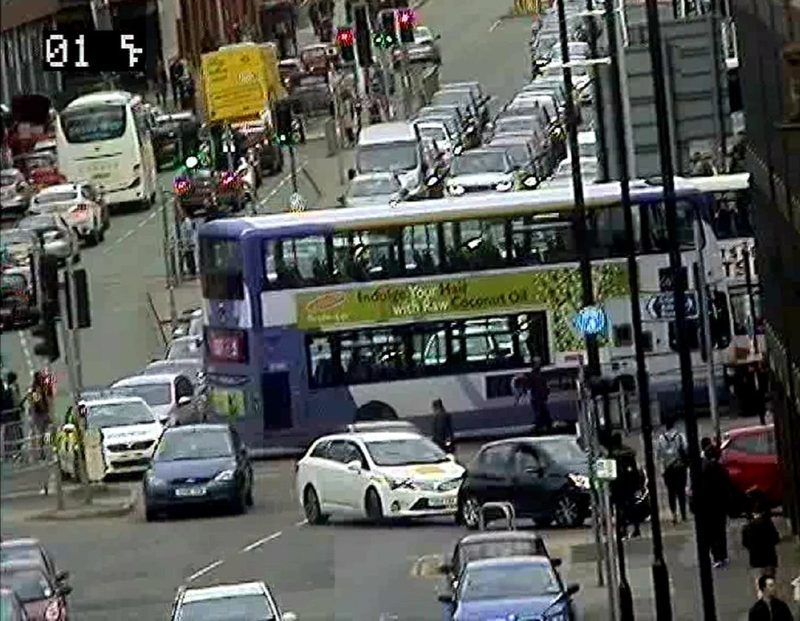
A business-as-usual mindset
The Council’s ‘improvement’ scheme maintains five lanes of traffic and removes the paltry cycle provision that currently exists. It looks pretty pathetic for a city that wishes to be a 'leading green city' and yet is spending millions to fall behind.
In contrast, the Netherlands have adopted integrated cycle infrastructure as a key tool to reduce congestion and improve air quality. Oslo, which is transitioning to a completely car-free city centre, is European’s Green City 2019.
For a time Manchester looked to be going in the right direction. In 2017, the Council signed up to the Made to Move strategy, committing to integrate walking and cycling into all public realm and infrastructure schemes at the development stage. While the Council will argue that the scheme was developed in 2016, the plans weren’t approved until May 2018.
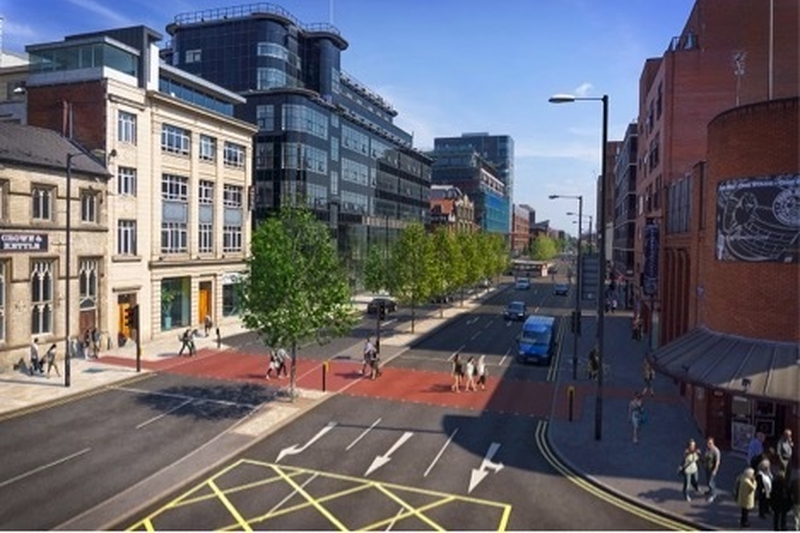
Lack of scrutiny
It turns out that the scheme was never properly scrutinised because the usual call-in time fell between local and European elections, when the Council is in purdah and activities are restricted. This is according to Cllr Richard Kilpatrick who calls the scheme “not fit for purpose” and, like many councillors, was shocked when he became aware of the plans and requested they be brought before the Scrutiny Committee.
The Lib Dem councillor argues that, “we should have sustainable transport at the heart of everything we do as a city, in line with our carbon target ambitions.” He would like the alternative proposal (more on this below) looked into and for the Council to publish rejected proposals - developed in 2016 but not shown to the public - that all included segregated cycleways. The Council’s decision to move forward with a scheme removing cycle lanes has been a further kick in the teeth for those who thought Manchester had started moving in a greener direction.
Unfortunately, the Council’s head is stuck in the sand, with official response to my queries around the scheme being segregated cycle lanes “would result in increased congestion”. This is despite decades of evidence to the contrary. “Induced demand” – more space for more cars – leads to more congestion, not bike lanes.
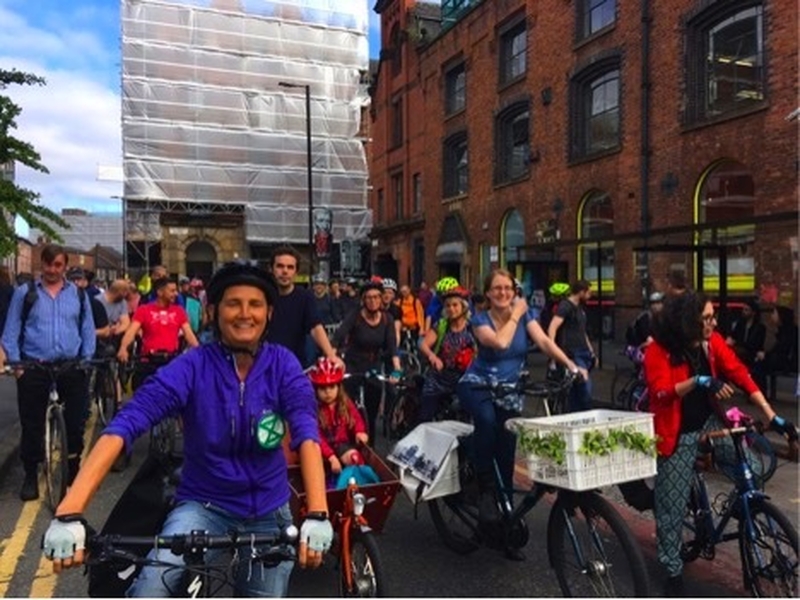
Provoking protest
Members of the public, as well as environmental groups, were aghast when the Council announced in May that work would be starting shortly. While there had been a brief consultation in 2018, it was hardly publicised, poorly attended, and plans stated “no overall change” despite the removal of cycle lanes. It was yet another example of a sham consultation.
The scheme is so out-of-step with current rhetoric and purported initiatives - the Carbon Neutral targets, Clean Air, and ‘Bee Network’ integrated cycle infrastructure - that it galvanised activist groups and members of the public across the city. A large protest was held in June with speakers from various groups, including Extinction Rebellion, which garnered wide media attention.
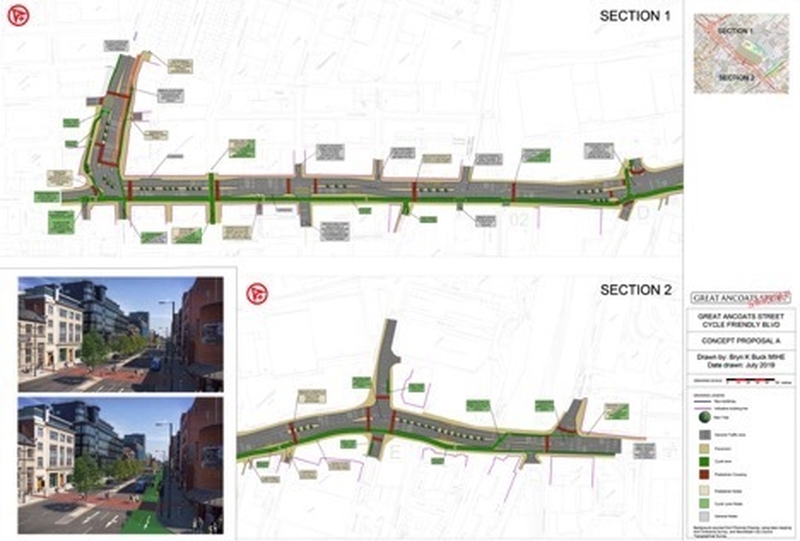
An alternative proposal with ambition
Of the many dismayed by the Council’s scheme was Highways Engineer Bryn Buck who first heard mention of the plans on Twitter: “I figured instead of just being another angry dissenting voice I would try and provide a positive alternative to provoke discussion.”
What Buck did next was twofold. First, he carefully reviewed the Council’s plans and identified 21 safety problems, highlighting the mediocrity of the plans overall. In a nutshell: key junctions lack pedestrian crossings, the plans omit safe cycle infrastructure, and the excessive number of traffic lights will cause stop-start traffic, idling and thus further pollution.
In its place, Buck developed a ‘Boulevard Concept’ alternative proposal. It maintains four lanes of traffic, includes a new mid-block pedestrian crossing, a continuous bi-directional segregated cycle lane, a walking and cycling corridor connecting Ancoats to the city centre, and rationalises the number of turns to improve traffic flow.
This proposal has been showcased on a website created by other members of the public to demonstrate what the Council could achieve with ambition.
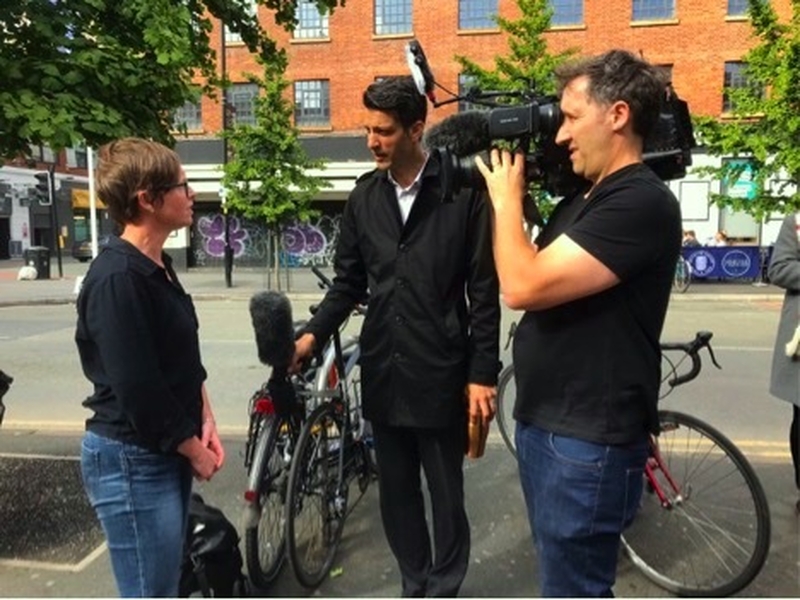
The shady trees
The Council has promoted their ‘improvement’ scheme as an exciting, forward-looking plan, gushing about the pedestrian crossings and the tree-lined street. Yet even these trees have an edge to them.
They were a late addition to the plans - added in September 2018 after the scheme was approved - and are replacements for trees cut down on Regents Road that were meant to be replanted but never were due to “insufficient space”. Moreover, these replacement trees are funded by a developer who hasn’t included social housing in their development and has made a s106 contribution instead. So while the trees are very much welcome, they aren’t really a net gain for the city.

A lack of political will
Overall, it’s no surprise the plans went before the Scrutiny Committee. In the meeting, which I attended, councillors voiced their concerns regarding the scheme, all agreeing that the lack of meaningful consultation was deeply troubling.
Cllr Stogia responded to queries raised by the Councillors, confirming to Cllr Kilpatrick that funding for the scheme runs out in March 2021. With work on the current scheme due to complete in February 2021, this suggested there isn’t time available to revisit the plans.
Yet Committee members were having none of it. Chair of the Committee Cllr Lee-Ann Igbon stressed “It’s not about time, it’s about getting it right”.
Cllr Kilpatrick questioned why there was only one month collateral built into the scheme between completion and funding supposedly drying up. Later, Labour Cllr Jon-Connor Lyons told me, “If [the conditions are] regarding a time limit, then they should have been quicker and anticipated potential set-backs.”
Following from this the Great Ancoats Street regeneration WILL be on the Neighbourhoods and Environment Scrutiny Committee as urgent business 17th July 2pm #GreatAncoatsStreet #GreatAncoatsStSwindle https://t.co/ad6rAgyAaH
— Cllr Richard Kilpatrick (@RKilpatrickMCR) July 11, 2019
Although preparatory works for the Great Ancoats Scheme have already started, the main work doesn’t begin until January 2020. Moreover, the contract hasn’t actually been awarded yet, meaning there’s still time to reconsider the scheme - however unusual that may be in a business-as-usual context.
But we’re not supposed to be in a business-as-usual context anymore.
“An emergency means you can do extraordinary things to avoid risk,” Nick Hubble tells me. If there are stipulations around the funding, he says, the Council can go back to central government in light of the Emergency and explain that the terms have changed.
The Scrutiny Committee have made the honorable and bold move to recommend the scheme go back out to consultation. Now it’s up to the Executive to agree the recommendation and ensure the scheme is subject to meaningful debate.
As we await the outcome next Wednesday, bear in mind Bryn Buck’s response when I asked him what motivated him to create his alternative plans: “I wanted to raise awareness that when someone says something’s impossible, the only usual blockage is political will.”
Follow Andrea Sandor at @wordstoseeby
Manchester City Council replies
I understand that it's not possible to pause and reevaluate the scheme now because plans are too far advanced and funding could be pulled. My understanding is this is because the funding comes through a government scheme that requires you to follow through with the original plans or risk losing the funding completely. Could you tell me what this scheme is called and where I can find out more about it? If the Council continued to work with the same partners, but revised the plans, wouldn't it be possible to continue and not lose the funding - especially in light of the climate emergency that's just been declared?
The Great Ancoats Street scheme is part of the Department for Transport's Growth Fund, which was targeted at cities to enable growth in the economy via transport improvements. The Great Ancoats Street scheme is aimed at encouraging growth in the area north of the city centre by providing improved access to the city centre via a number of new or improved crossing points for walking and cycling. There are also proposals to uplift the feel of the road itself by de-cluttering street furniture providing new footway surfaced and tree planting. The business case for the scheme concentrates on improved sustainable transport trips by walking and cycling between the developing growth area north of the city centre and the city centre itself. The impact of the scheme is neutral for general traffic on the inner ring road itself. Reducing the capacity of the inner ring road by adding segregated cycle lanes would result in increased congestion elsewhere on the surrounding roads and the potential for cars seeking alternative routes through local neighbourhoods, which would have a negative impact on their environment, growth in the city and may result in the funding being withdrawn. A careful balance was required to get the benefits being sort without creating problems elsewhere.
The funding deadline for completion of all Growth Fund scheme is March 2021. This includes final claims. The current works programme would finish around February 2021.
What other barriers stand against revising the plans? And what's at risk if works were to be paused and the plan reevaluated?
Providing segregated cycle lanes along the road itself would require removing either some of the proposed crossing improvements, pavement widths, trees or significantly reducing highway capacity, which would itself result in increased congestion and worsening air quality for the surrounding area. In the three-year period up to November 2016, there were nine pedestrian accidents on Great Ancoats Street, of which three were reported as serious, which demonstrates the vital importance of improving crossing facilities for people on foot.
We are proposing to provide a significant new area wide cycling network both sides of Great Ancoats Street, with links to radial routes coming into the City Centre from further afield. Part of these proposals will be to reduce through traffic in areas such as the Northern Quarter and Stevenson Square.
What has the Council learned from the backlash against the Great Ancoats Street scheme?
Please see a comment from Cllr Stogia below.
Executive Member for the Environment, Planning and Transport, Cllr Angeliki Stogia, said:
"We know that people care passionately about being able to cycle and walk safely around Manchester city centre and this is an agenda which we wholeheartedly support. We are fully committed to investing in new cycling and walking infrastructure that will make these methods of transport the natural choice for people getting around in the city centre.
"Great Ancoats Street is part of the city centre’s inner ring road and as such is an extremely busy route. The transformation we are working on will deliver enhanced crossings for people travelling on foot or by bike, to allow them to cross this major road much more safely and travel more easily between the city centre and the flourishing Ancoats area. Consultation revealed that many respondents appreciated the way this scheme addresses the problem people have in crossing the road safely.
"At the same time, we are committed to creating two new dedicated cycling and walking corridors running parallel to Great Ancoats Street - the Northern and Eastern Gateway project and the Piccadilly - Victoria route. Both of these schemes will be funded by the Greater Manchester Mayor’s Challenge Fund and will form part of the growing GM Bee Network.
"Pedestrian benefits of the Great Ancoats Street scheme will include new and improved crossings, some of which are shared with cyclists, plus tree planting and decluttering of footways. As well as delivering a significantly enhanced experience for pedestrians, the scheme will encourage motorists not to use the surrounding smaller roads as ‘rat-runs’, which would lead to reduced air quality and more risk of collisions across Ancoats and the city centre.
"Taken as a whole, these three projects will deliver a radically improved, safer infrastructure for both pedestrians and people travelling by bike across Manchester city centre."





